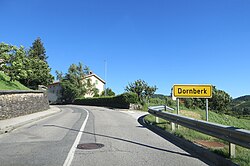Dornberk
Dornberk
Zali Hrib (1948–1952) | |
|---|---|
 | |
 Dornberk Location in Slovenia | |
| Coordinates: 45°53′21.08″N 13°44′9″E / 45.8891889°N 13.73583°ECoordinates: 45°53′21.08″N 13°44′9″E / 45.8891889°N 13.73583°E | |
| Country | |
| Traditional region | Slovenian Littoral |
| Statistical region | Gorizia |
| Municipality | Nova Gorica |
| Area | |
| • Total | 1.08 km2 (0.42 sq mi) |
| Elevation | 60.7 m (199.1 ft) |
| Population (2002) | |
| • Total | 795 |
| [1] | |
Dornberk (pronounced [ˈdoːɾnbɛɾk]; Italian: Montespino) is a village in western Slovenia in the Municipality of Nova Gorica.[2] It is located in the Vipava Valley within the Gorizia region of the Slovenian Littoral. Dornberk is the centre of a local community that includes the satellite settlements of Potok pri Dornberku, Saksid, Brdo, Tabor, Draga, Zalošče, and Budihni. The entire local community has a population of around 1,800.
Name[]
The Slovene name of the village comes from German Dornberg, meaning 'thorn hill'. This was also the official name until the end of World War I, when the village came under Italian administration. At first, the Italians used an historical version of the traditional name of the village, Dorimbergo,[3] but during the Fascist period the name was changed to Montespino, which is a literal Italian translation of the German name. After World War II, the village briefly reacquired its old name, but in 1948, the name was changed again because of its German sound, and the name Zali Hrib (literally, 'fair hill') was invented. The locals rejected the new designation and demanded the old name back. The name of the settlement was changed to Dornberk in 1952, but the final -g was replaced with a -k.[4] Nevertheless, the locals still refer to it as Dornberg rather than Dornberk. This phonetic difference is not perceived in standard Slovene, in which the final voiced velar stop /g/ is pronounced as voiceless /k/. However, in the local Karst dialect spoken in the lower Vipava Valley, /g/ has developed into the voiced glottal fricative /ɦ/, and often a voiceless glottal fricative at the end of words.
Church[]
The parish church in the settlement is dedicated to the Prophet Daniel and belongs to the Diocese of Koper.[5]
The area of Dornberk is known for the production of wine and fruits, especially peaches, apricots, and pears.
See also[]
- Gorizia and Gradisca
- Austrian Littoral
- Julian March
- Vito of Dornberg
- Wines of Slovenia
References[]
- ^ Statistical Office of the Republic of Slovenia
- ^ Nova Gorica municipal site
- ^ Dorimbergo in Udine illustrata, part I, of Giovanni Capidogli (1665): "La Famiglia da Rabatta è di nobiltà isquisita, ed immemorabile; onde fino da Enrico Terzo Re de' Romani fu degnamente presa in sua protezione, confermandole, ... donandole libere tante, e così ampie giurisdizioni nella Toscana, che formavano un considerabile, e non picciolo Stato. Non avendo poi la fortuna con pregresso di tempo per li molti, e vari accidenti di guerra, ripigliati quei beni, che prima le aveva concesso, si ricoverò la suddetta Famiglia nella Repubblica Fiorentina, nella quale fu tenuta, e pregiata delle più nobili, conseguendo in quella tutti li principali maneggi ec. Indi per le fazioni de' Guelfi, e Ghibellini passò nel Friuli, e prese posto in Udine già Quattrocento, e più anni ed avendo più tempo quivi dimorando godendo della Signoria di tre Castella, si condusse finalmente nel Contado di Gorizza, dove poscia ottenne in Feudo il Castello di Dorimbergo con altre giurisdizioni, che oggidì parimenti si conservano nella medesima Famiglia" in: Istoria del Decamerone di Giovanni Boccaccio scritta da Domenico Maria Manni Accademico fiorentino, in Firenze MDCCXXXXII (1742)
- ^ Spremembe naselij 1948–95. 1996. Database. Ljubljana: Geografski inštitut ZRC SAZU, DZS.
- ^ Roman Catholic Diocese of Koper List of Churches May 2008 Archived March 6, 2009, at the Wayback Machine
External links[]
 Media related to Dornberk at Wikimedia Commons
Media related to Dornberk at Wikimedia Commons- Dornberk on Geopedia
- Populated places in the City Municipality of Nova Gorica
- Goriška statistical region geography stubs

